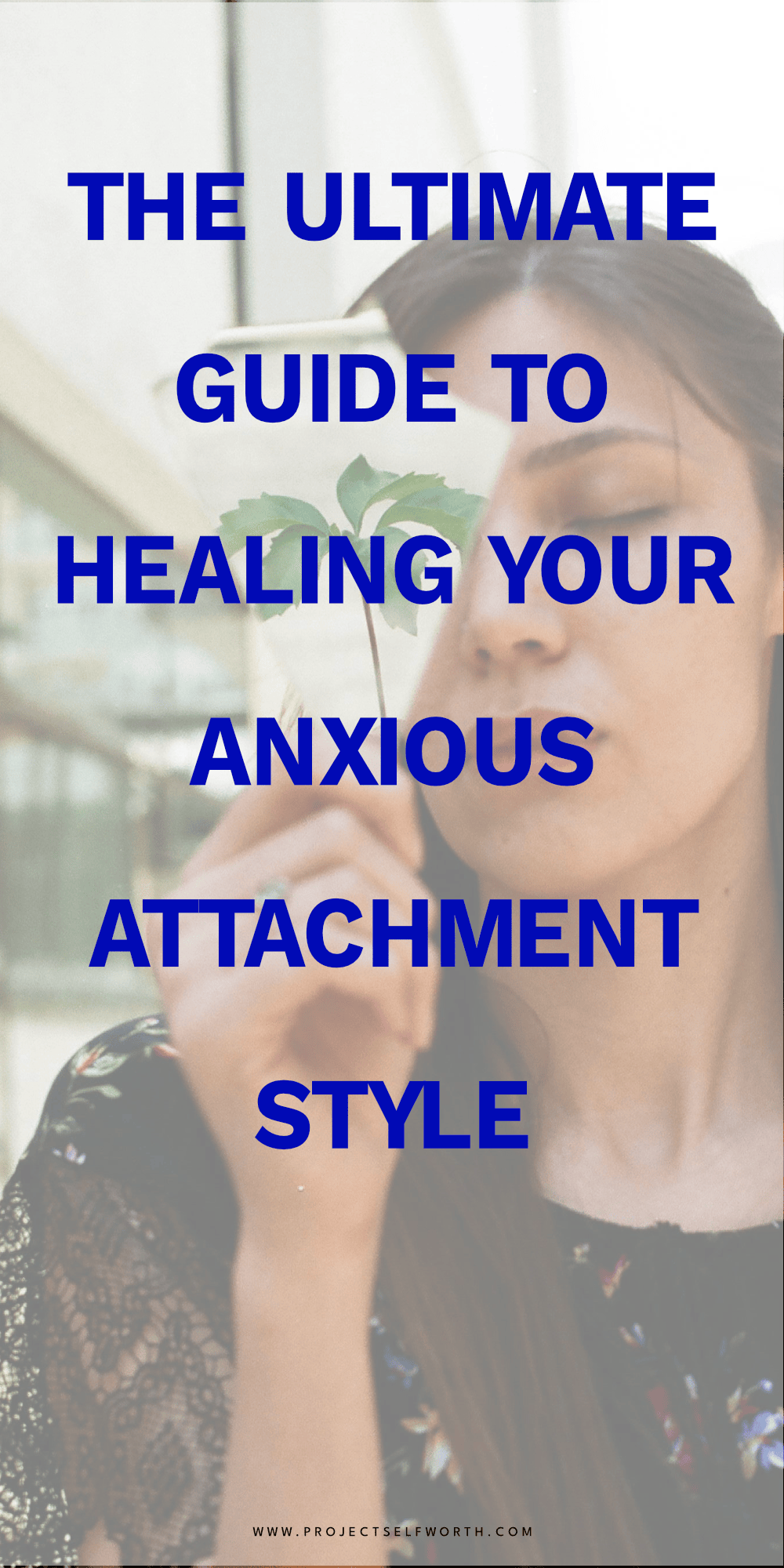The Ultimate Guide To Healing Your Anxious Attachment Style
Living with anxious attachment can be rough.
Can’t stop wondering if someone likes you or not? Turning yourself into a human pretzel trying to keep them interested? Getting your heart absolutely crushed when someone ghosts after the first date?
All of those things are potential signs of an anxious attachment style.
Look, sometimes it is them. But for the anxious attachments, mostly it’s you. You simply have an inner hunger for love that runs so deep, than even being in an actual relationship doesn’t make it go away.
This can result in feelings of low self-worth, toxic people-pleasing, and feeling like you’re on a never-ending emotional rollercoaster.
Fundamentally, anxious attachment is a deeply-rooted fear of rejection that manifests as constantly worrying about your partner’s (or potential partner’s) feelings, and having low self-esteem. For example, thinking you have to make someone like you through your actions because they couldn’t possibly just like you on you own.
But here’s the good news: you can learn to self-soothe and heal your anxious attachment style, whether you’re currently in a relationship or not.
What is Anxious Attachment?
Anxious attachment is an insecure attachment style marked by a fear of abandonment and a constant need for reassurance.
Here are some signs of an anxious attachment style:
- Excessive worry about being disliked or rejected
- Difficulty trusting others
- Clingy or jealous behavior
- Difficulty expressing emotions
Psychologist Mary Ainsworth identified anxious attachment as one of four attachment styles. (The others are avoidant, secure, and disorganized.) These styles are rooted in our early relationships with caregivers, according to Attachment Theory.
Here’s the gist of it:
We’re wired to connect with caregivers for survival as infants. These early interactions become a blueprint for how we connect with loved ones later, including romantic partners.
Our attachment style develops throughout childhood as we learn how to get our needs met from caregivers. The quality of care we receive shapes our view of the world: safe and secure, or unsafe and demanding. This is where secure vs. insecure attachment styles come in.
How Anxious Attachment Affects You
Anxious attachment can impact your emotional well-being and relationships. It can lead to:
- Low self-worth
- Excessive people pleasing
- Anxiety and depression
Difficulty setting or maintaining boundaries
Unsatisfying or unstable relationships (including “attracting” narcissists)
How to Self-Soothe Anxious Attachment
Anxious attachment can be painful, but there are ways to build a more secure style. Of course, therapists can help clients feel calmer and more secure in their partnerships. But there’s plenty of actions you can take without going to a therapist.
1. Change Your Pattern
Our past experiences shape how we react in relationships. So a great way to change is by consciously choosing to behave differently than how you used to.
For example: if you typically double text or immediately bring up something that has triggered your insecurity, try the opposite.
Pause and and ask yourself:
- Is this reaction driven by anxiety?
- Will it truly make me feel better?
Hold off on anxious behaviors. If you have an urge to reach out impulsively, resist! Wait until you’ve calmed down, then decide if the issue needs addressing. (Scroll down to see our tips on calming your nervous system below!)
2. Prioritize Yourself
When your attention is constantly focused outside of yourself, you run the risk of losing touch with your actual feelings.
For example, you start to lose your mind over whether or not someone likes you instead of realizing that you actually don’t click with this person very much in the first place.
Let’s get you back in touch with you. Here’s a few ideas:
- Spend time alone or with loved ones outside your romantic relationship.
- Set new goals in areas like work, fitness, or personal development.
- Treat yourself! Take yourself on solo dates, enjoy hobbies, or simply relax
- with minimal distractions.
By focusing on your own well-being, you’ll feel more secure and fulfilled.
3. Set Boundaries
Anxious attachments struggle with setting boundaries or advocating for their needs in general. This usually stems from a childhood experience where they were told or shown their needs were inconvenient or unimportant.
However, having healthy boundaries is essential to your overall mental well-being–not narcissistic.
- Remind yourself that those who truly love and appreciate you will also respect your boundaries.
- Start by vocalizing your preferences in low stakes situations (like with which restaurant to choose). This will make you more comfortable advocating for yourself over time.
- Identify the places where you truly need to set a boundary (vs a preference). Then set one: state what you need and also what you will do if the boundary gets crossed. Then be prepared to follow through! There might be pushback at first, especially if something has been going on for a long time.
- If someone is unwilling to change unhealthy patterns or respect your boundaries, consider limiting contact or ending the relationship.
4. Take A Break
Acknowledge your limitations. You’re on a learning journey towards secure attachment. It’s okay to avoid situations or people who trigger your anxiety, especially initially. Again, focus on doing the best you can for you.
Seek Professional Help
A therapist can help you explore the root causes of your attachment anxiety and develop healthier coping mechanisms.
Remember, building secure attachment takes time and effort. By challenging your instincts, prioritizing self-care, and setting boundaries, you’ll be well on your way to healthier, more fulfilling relationships.
Retraining Your Nervous System
Another part of self-soothing is teaching your nervous system that distance or uncertainty in relationships won’t actually kill you–even though it may feel that way!
This means allowing yourself to tolerate those initial feelings of distress and to calming your nervous system without seeking reassurance from your partner. (Think: during arguments, waiting for a text, or fearing your partner’s anger.) Over time, you’ll trust yourself and these feelings to pass. This is about building skills to weather these storms.
Nervous System Calming Techniques
When anxious attachment hits, it’s hard to know what helps. Here are some ideas for you to put into you own personal self-healing toolkit:
Calming Your Nervous System
- Do a progressive muscle relaxation exercise
- Taking a walk
- Do jumping jacks for 30 seconds
- Deep breathing exercises
- Havening
- Pett your dog or cat
Distraction Techniques
- Watching a favorite TV show
- Play a video game
- Do a few chores (This uses up energy and leaves you feeling accomplished!)
- Run a few errands
- Visit your favorite cafe
- Take a walk
Processing Your Feelings and Thoughts
- Use a feelings wheel to identify your emotions
- Talk to a friend
- Talk yourself through the situation outloud (Record it into your phone if you like!)
- Challenge your worst-case scenarios with medium and best-case ones
- Journal
- Talk with a therapist
Want more?
Find out how to create secure attachment here!
Ready to work through your anxious attachment with the help of a therapist? But can’t quite afford to pay the full price? Try out BetterHelp for convenient, affordable therapy you can start at home.
So what did you think? Did you learn anything new about your attachment style today? Which tip are you going to focus on in your own healing journey?
Remember, healing takes time and effort. Don’t stress yourself out by trying to become “perfect” in one weekend.
All the little steps you take add up into big changes over time. By putting in the work, you can feel more confident in yourself, get off the emotional rollercoaster, build more fulfilling relationships and experience greater emotional well-being

Love This Post? Then Save It To Pinterest!







